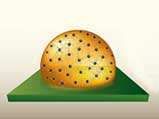Researchers at Rensselaer Polytechnic Institute have demonstrated that liquids embedded with nanoparticles show some interesting properties when exposed to electric fields.
The manipulation of small volumes of liquid is critical for fluidic digital display devices, optical devices, and microelectromechanical systems such as lab-on-chip analysis systems. Yet most research into such systems to date has been conducted with regular liquids, but not nanofluids, which are liquids embedded with different nanoparticles.
Now, however, Theodorian Borca-Tasciuc, a professor of mechanical engineering at Rensselaer has shown that such nanofluids have some very interesting properties.
To illustrate, Prof Borca-Tasciuc and his team placed droplets of water-based solutions containing bismuth telluride nanoparticles onto a Teflon-coated silicon wafer. When an electric field was applied to the droplet, the researchers observed a strong change in the angle at which the droplet contacted the wafer. This change was much higher than that observed in liquids without the nanoparticles.
'You use the same electrical field, but you get more change in shape with the nanofluid. We know the nanoparticles are critical in this process because without them the effect is much less strong,' Borca-Tasciuc said.
The ability to easily change the contact angle of droplets of nanofluids has potential applications for efficiently moving liquids in microsystems, creating new methods of focusing lenses in miniature cameras, or cooling computer chips. Prof Borca-Tasciuc also envisions the research enabling new fully integrated micro- and nanoscale heat transfer systems that will not require a pump.
The research was funded in part by the US National Science Foundation and the New York State Foundation for Science, Technology and Innovation through the Interconnect Focus Center.

The contact angle of a droplet of nanofluid solution changes when exposed to an electric field.
Image Credit: Rensselaer/Borca-Tasciuc




Nanogenerator consumes CO2 to generate electricity
Nice to see my my views being backed up by no less a figure than Sabine Hossenfelder https://youtu.be/QoJzs4fA4fo